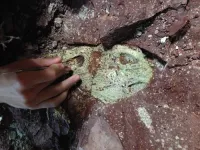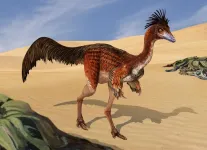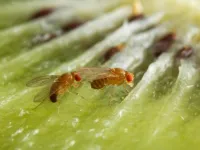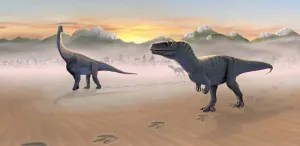(Press-News.org) In a small study of eight cats at early stages of pregnancy, researchers detected 19 different kinds of microplastic particles in fetuses from two cats and in the placentas of three cats. Ilaria Ferraboschi of the University of Parma, Italy, and colleagues present these findings in the open-access journal PLOS One on April 2, 2025.
Humans and other animals worldwide are increasingly exposed to microplastics, which are small particles of plastic contaminants. Studies suggest that microplastics can have a variety of adverse health effects. For instance, research in rodents suggests that fetuses exposed to microplastics during pregnancy may experience impaired development. Microplastics have also been found in human amniotic fluid, further raising concerns about fetal exposure.
To deepen understanding of this topic, Ferraboschi and colleagues investigated whether microplastics can be found in cat placentas and fetuses during early stages of pregnancy. They evaluated eight pregnant stray cats that had been brought to a veterinary hospital as part of a population-control program in northern Italy.
Using a standard chemical analysis technique known as Raman spectroscopy, the researchers detected microplastics in fetal tissue from two of the cats and in placental tissue from three of the cats. They found a total of nineteen different types of microplastics in the tissue samples.
These findings show that, even during early stages of pregnancy, microplastics may accumulate in cat placentas. They also suggest that microplastics may be able to cross the placental barrier and accumulate in cat fetuses. However, further research will be needed to determine whether microplastics in cat placentas and fetuses might impact fetal health and development.
In light of their findings and the findings of earlier studies, the researchers call for limits on the general use of plastics and development of alternative materials. They also call for policymakers and industrial stakeholders to enact strategies for mitigating plastic pollution that poses risks to humans and animals.
In your coverage, please use this URL to provide access to the freely available article in PLOS One: https://plos.io/4hua1jP
Citation: Ferraboschi I, Canzolino F, Ferrari E, Sissa C, Masino M, Rizzi M, et al. (2025) Detection of microplastics in the feline placenta and fetus. PLoS ONE 20(4): e0320694. https://doi.org/10.1371/journal.pone.0320694
Author countries: Italy
Funding: This research was supported by the Program “FIL-Quota Incentivante” of University of Parma and co-sponsored by Fondazione Cariparma. The work has benefited from the equipment and framework of the COMP-HUB Initiative, funded by the “Departments of Excellence program of the Italian Ministry for Education, University and Research (MIUR, 2018−2022). IF benefited of a PhD fellowship financed by PON R&I 2014-2020 (FSE REACT EU fundings). The funders had no role in study design, data collection and analysis, decision to publish, or preparation of the manuscript.
END
Microplastics detected in cat placentas and fetuses during early pregnancy
Small study suggests cat fetuses could potentially be exposed to microplastics through placentas
2025-04-02
ELSE PRESS RELEASES FROM THIS DATE:
Ancient amphibians as big as alligators died in mass mortality event in Triassic Wyoming
2025-04-02
Dozens of amphibians perished together on an ancient floodplain around 230 million years ago, according to a study published April 2, 2025 in the open-access journal PLOS One by Aaron M. Kufner of the University of Wisconsin-Madison, U.S., and colleagues.
Early in the Age of Dinosaurs, alligator-sized amphibians called metoposaurid temnospondyls were common in freshwater habitats. Several fossil sites contain large concentrations of temnospondyls buried together, but determining how these bonebeds formed is often difficult due to ...
Scientists uncover the first clear evidence of air sacs in the fossilized bones of alvarezsaurian dinosaurs: the "hollow bones" which help modern day birds to fly
2025-04-02
Article URL: https://plos.io/4hxJYYP
Article title: First unambiguous record of pneumaticity in the axial skeleton of alvarezsaurians (Theropoda: Coelurosauria)
Author countries: Argentina, China
Funding: We thank P. Chafrat from Museo Patagónico de Ciencias Naturales, General Roca, Río Negro Province, Argentina. The authors gratefully acknowledge "Fundacion Patagonica de Ciencias Naturales" and "Sanatorio Juan XXIII" for making the CT images possible. MP was supported by the Faculty of Science of The Chinese University of Hong Kong. We thank Hans-Dieter Sues, an anonymous reviewer, and the editorial team of PLOS ONE for their comments ...
Alcohol makes male flies sexy
2025-04-02
The fruit fly Drosophila melanogaster is also known as the pomace or vinegar fly. It can be found in large numbers in organic waste bins during the summer and in the fruit and vegetables section of grocery stores on hot days. It is attracted to the odor of pre-rotting fruit, where microorganisms, especially yeasts, have multiplied and invaded the fruit and switched their metabolism to alcoholic fermentation. This is why rotten fruit contains significant amounts of alcohol.
Alcohol consumption requires a risk assessment
There is no doubt that the consumption of large amounts of alcohol is harmful to human beings.. ...
TB patients globally often incur "catastrophic costs" of up to $11,329 USD, despite many countries offering free treatment, with predominant drivers of cost being hospitalization and loss of income
2025-04-02
TB patients globally often incur "catastrophic costs" of up to $11,329 USD, despite many countries offering free treatment, with predominant drivers of cost being hospitalization and loss of income.
####
Article URL: https://plos.io/3QXqJ07
Article Title: The catastrophic cost of TB care: Understanding costs incurred by individuals undergoing TB care in low-, middle-, and high-income settings – A systematic review
Author Countries: Canada, Eswatini, Germany, United States
Funding: The authors received no specific funding for ...
Study links teen girls’ screen time to sleep disruptions and depression
2025-04-02
Excessive screen time among adolescents negatively impacts multiple aspects of sleep, which in turn increases the risk of depressive symptoms — particularly among girls. That is the conclusion of a new study published this week in the open-access journal PLOS Global Public Health by Sebastian Hökby of Karolinska Institutet, Sweden, and colleagues.
Recently, the Swedish Public Health Agency published recommendations that adolescents use no more than two-to-three hours of daily leisure screen time, partly to promote better sleep. ...
Scientists unveil starfish-inspired wearable tech for heart monitoring
2025-04-02
When we move, it’s harder for existing wearable devices to accurately track our heart activity. But University of Missouri researchers found that a starfish’s five-arm shape helps solve this problem.
Inspired by how a starfish flips itself over — shrinking one of its arms and using the others in a coordinated motion to right itself — Sicheng Chen and Zheng Yan in Mizzou’s College of Engineering and collaborators have created a starfish-shaped wearable device that tracks heart health in real time.
Because the starfish-inspired device has multiple points touching the skin near the heart, it stays more ...
Footprints reveal prehistoric Scottish lagoons were stomping grounds for giant Jurassic dinosaurs
2025-04-02
Jurassic dinosaurs milled about ancient Scottish lagoons, leaving up to 131 footprints at a newly discovered stomping ground on the Isle of Skye in Scotland, according to a study published April 2, 2025 in the open-access journal PLOS One by Tone Blakesley of the University of Edinburgh, Scotland and colleagues.
In the rocks of the Isle of Skye, dinosaur footprints are abundant, providing insights into dinosaur distribution and behavior during an important time in their evolution. The footprints were left in the rippled sands of an ancient subtropical lagoon, dating back to the Middle Jurassic ...
AI effectively predicts dementia risk in American Indian/Alaska Native elders
2025-04-02
Irvine, Calif., April 2, 2025 — Machine learning algorithms utilizing electronic health records can effectively predict two-year dementia risk among American Indian/Alaska Native adults aged 65 years and older, according to a University of California, Irvine-led study. The findings provide a valuable framework for other healthcare systems, particularly those serving resource-limited populations.
The computer modeling results also found several new predictors for dementia diagnosis that were identified consistently across different machine-learning models. Findings are published in the Lancet Regional Health – Americas. The National Institutes ...
First guideline on newborn screening for cystic fibrosis calls for changes in practice to improve outcomes
2025-04-02
The United States Cystic Fibrosis Foundation released the first guideline on newborn screening for cystic fibrosis (CF), in order to improve timely detection of CF in infants from all racial and ethnic backgrounds. The new guideline, based on systematic literature reviews and published in the International Journal of Neonatal Screening, reflects rigorous scientific investigation and perspectives from parents, CF specialists, public health representatives, primary care providers and genetic counselors.
CF is a genetic disorder that causes problems with digestion and breathing. Currently, newborns in every state are screened for ...
Existing international law can help secure peace and security in outer space, study shows
2025-04-02
World leaders should look to existing international law on the use of force to address the threat of space becoming ever more militarized, a new study shows.
Space has the potential to be a source and place of armed conflict and regulating military activities in space is of pressing international concern.
Tests of anti-satellite (ASAT) weapons have fuelled fears of warfare in space. Resulting space debris from ASAT weapon threatens other satellites in orbit, many of which underpin the operation of human societies and the functioning of global economies.
Conflict ...
LAST 30 PRESS RELEASES:
Scalable and healable gradient textiles for multi‑scenario radiative cooling via bicomponent blow spinning
Research shows informed traders never let a good climate crisis go to waste
Intelligent XGBoost framework enhances asphalt pavement skid resistance assessment
Dual-function biomaterials for postoperative osteosarcoma: Tumor suppression and bone regeneration
New framework reveals where transport emissions concentrate in Singapore
NTP-enhanced lattice oxygen activation in Ce-Co catalysts for low-temperature soot combustion
Synergistic interface engineering in Cu-Zn-Ce catalysts for efficient CO2 hydrogenation to methanol
COVID-19 leaves a lasting mark on the human brain
Scientists use ultrasound to soften and treat cancer tumors without damaging healthy tissue
Community swimming program for Black youth boosts skills, sense of belonging, study finds
Specific depressive symptoms in midlife linked to increased dementia risk
An ‘illuminating’ design sheds light on cholesterol
Who is more likely to get long COVID?
Study showcases resilience and rapid growth of “living rocks”
Naval Research Lab diver earns Office of Naval Research 2025 Sailor of the Year
New Mayo-led study establishes practical definition for rapidly progressive dementia
Fossil fuel industry’s “climate false solutions” reinforce its power and aggravate environmental injustice
Researchers reveal bias in a widely used measure of algorithm performance
Alcohol causes cancer. A study from IOCB Prague confirms damage to DNA and shows how cells defend against it
Hidden viruses in wastewater treatment may shape public health risks, study finds
Unlock the power of nature: how biomass can transform climate mitigation
Biochar reshapes hidden soil microbes that capture carbon dioxide in farmland
Reducing saturated fat intake shows mortality benefit, but only in high-risk individuals
Manta rays create mobile ecosystems, study finds
Study: Mixed results in using lipoic acid to treat progressive multiple sclerosis
Norbert Holtkamp appointed director of Fermi National Accelerator Laboratory
New agentic AI platform accelerates advanced optics design
Biologists discover neurons use physical signals — not electricity — to stabilize communication
Researchers discover that a hormone can access the brain by hitchhiking
University of Oklahoma researcher awarded funding to pursue AI-powered material design
[Press-News.org] Microplastics detected in cat placentas and fetuses during early pregnancySmall study suggests cat fetuses could potentially be exposed to microplastics through placentas








